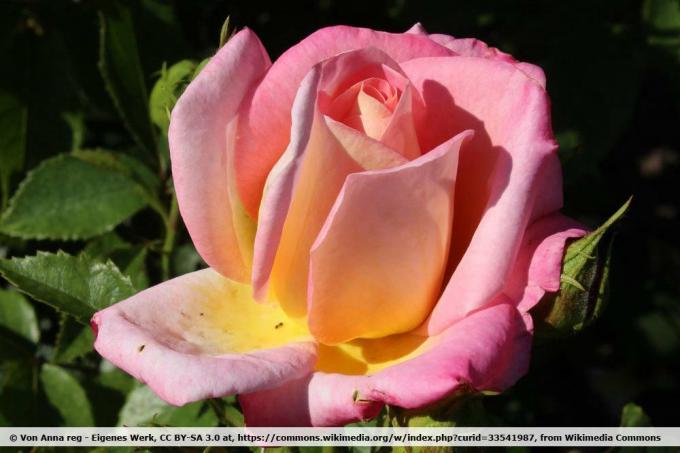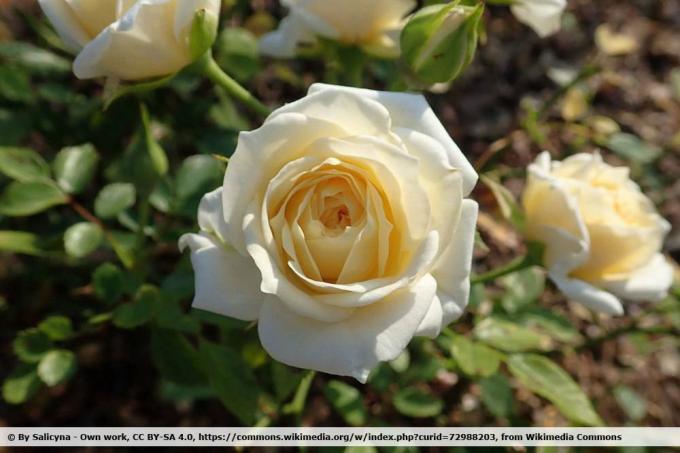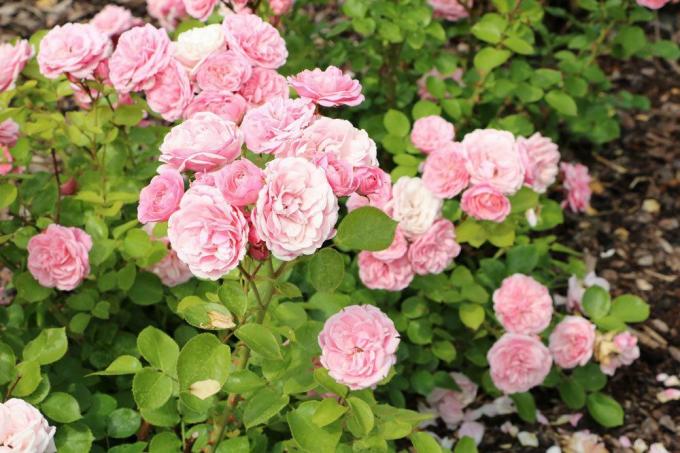
table of contents
- 30 varieties of roses
- Hybrid Tea Roses
- Shrub roses
- Floribunda roses
- Dwarf roses
- Ground cover roses
- Climbing roses
- Alternative: wild rose species
Roses are the classic of a fairytale garden and with over 30,000 varieties you can lose the overview. For the local latitudes there are several types of roses that are immediately noticeable due to their flowers and scent. Decoratively, they fit into the picture and some of them are even visited by insects with pleasure. With the right rose species and sorts, your garden becomes a colorful retreat.
30 varieties of roses
The search for the right roses is made easier if you have a clear list available. Roses have been one of the most popular garden plants for centuries, so it is not surprising that the number of varieties is so extensive. The individual rose species from which the varieties originate are all found within the rose genus, which means that they share many characteristics with one another. The rose varieties listed below are divided into six categories:
- Hybrid Tea Roses
- Shrub roses
- Floribunda roses
- Dwarf roses
- Ground cover roses
- Climbing roses
These are the typical classifications into which roses are divided, especially in Central Europe. The list contains 30 rose varieties, with the individual properties of the corresponding variety being clearly presented. You will also receive a brief explanation of what distinguishes the groups from the others. This means that you can quickly find the right rose varieties for your garden.
Hybrid Tea Roses
Hybrid tea roses are types of roses that form long flower stalks so that they can then be easily cut for vases and flower arrangements. On the other hand, they do not develop as much green as other varieties, which sometimes makes them appear a bit sparse in larger groups. They often develop intense flower colors and less fragrance.
1. Bellevue
- Flower: intense to purple red, double
- Flowering period: mid-April to October
- Height: 70 to 90 centimeters
- Width: 40 to 50 centimeters
- Location: sunny to partially shaded
- Fragrance: weak
- Hardy: yes
2. charisma
- Flower: magenta, double
- Flowering period: June to the end of September
- Height: 100 to 120 centimeters
- Width: 60 to 70 centimeters
- Location: sunny to shady
- Fragrance: weak
- Hardy: yes

3. Countess Diana
- Flower: purple-red, double
- Flowering period: June to mid-September
- Height: 90 to 120 centimeters
- Width: 40 to 60 centimeters
- Location: sunny to shady
- Scent: exceptionally strong scent
- Winter hardy: conditional

4. inspiration
- Flower: yellow and salmon pink, double
- Flowering period: beginning of June to mid-October
- Height: 60 to 80 centimeters
- Width: 50 to 60 centimeters
- Location: sunny
- Fragrance: nonexistent
- Hardy: yes

5. Maxim
- Flower: creamy white to pink, double
- Flowering period: beginning of June to October
- Height: 70 to 100 centimeters
- Width: up to 60 centimeters
- Location: sunny
- Scent: intense
- Winter hardy: conditional

6. Sunny Sky
- Flower: light yellow, double
- Flowering period: mid-June to October
- Height: 100 to 120 centimeters
- Width: 50 to 60 centimeters
- Location: sunny to partially shaded
- Fragrance: weak
- Winter hardy: conditional
Shrub roses
If you choose these roses, you can look forward to spreading shrubs that reach heights of up to three meters and have a very dense growth. They are excellent to raise as hedges, as they are highly branched and free-flowering. Many of the rose varieties within this category are also counted among the old and English roses.
1. Alexandra Princesse de Luxembourg
- Flower: pink, double
- Flowering period: June to mid-September
- Height: 100 to 140 centimeters
- Width: 50 to 100 centimeters
- Location: sunny to partially shaded
- Scent: very sweet
- Hardy: yes

2. Dinky
- Flower: intense pink, very double
- Flowering period: June to mid-September
- Height: 100 to 150 centimeters
- Width: 100 to 120 centimeters
- Location: sunny to shady
- Scent: pleasant
- Hardy: yes
3. Julia Renaissance
- Flower: pearly white to pink, double
- Flowering period: June to November
- Growth height: up to 150 centimeters
- Width: up to 90 centimeters
- Location: sunny to partially shaded
- Scent: pleasant
- Hardy: yes

4. Freising Dawn
- Flower: orange-yellow with a yellow base, semi-double
- Flowering period: July to the end of September
- Height: 130 to 170 centimeters
- Width: 60 to 100 centimeters
- Location: sunny to partially shaded
- Scent: intense
- Hardy: yes

5. Snow white
- Flower: snow-white, semi-double
- Flowering period: mid-June to mid-September
- Height: 100 to 120 centimeters
- Width: 60 to 80 centimeters
- Location: sunny to partially shaded
- Fragrance: delicate
- Hardy: yes

6. Westerland
- Flower: orange, half-double
- Flowering period: June to mid-November
- Height: 100 to 200 centimeters
- Width: 60 to 90 centimeters
- Location: sunny
- Fragrance: mediocre
- Hardy: yes

tip: If you are looking for a shrub rose with a particularly strong fragrance, you should give the 'Rose de Resht' a chance. This Portland rose (bot. Rosa portlandia) was also used in the past for the production of rose oil and draws attention to itself in large groups in the entire neighborhood with its beguiling scent.
Floribunda roses
Flowerbed roses are varieties that grow both compact and low. They reach an average maximum height of up to 80 centimeters and can be planted close to each other. Due to their low height, they can be placed in a space-saving manner.
1. Bonica '82
- Flower: soft pink, double
- Flowering period: June to the end of September
- Height: 50 to 80 centimeters
- Width: 60 centimeters
- Location: sunny to partially shaded
- Scent: not fragrant
- Hardy: yes

2. Easy going
- Flower: orange-copper, very double
- Flowering period: June to mid-September
- Height: 50 to 80 centimeters
- Width: 50 centimeters
- Location: sunny
- Scent: gentle
- Hardy: yes

3. Friesia
- Flower: golden yellow, semi-double
- Flowering period: June to the end of September
- Height: 50 to 70 centimeters
- Width: 30 to 40 centimeters
- Location: sunny to partially shaded
- Scent: fruity
- Winter hardy: conditional

4. Lions rose
- Flower: creamy white to pink, double
- Flowering period: beginning of June to mid-September
- Height: 70 to 80 centimeters
- Width: 40 to 50 centimeters
- Location: sunny to partially shaded
- Fragrance: weak
- Winter hardy: conditional

5. Milano
- Flower: scarlet red, semi-double
- Flowering period: June to the end of August
- Height: up to 60 centimeters
- Width: up to 40 centimeters
- Location: sunny to partially shaded
- Fragrance: weak
- Winter hardy: conditional

tip: In the case of bed roses, it is also advisable to look for varieties with an ADR seal, the "Recognized German Roses". Because compared to many other rose varieties, they are ideal for the German garden, as they are unfavorable locations, partial shade, Diseases and Pests endure well and thus ensure joy for a long time.
Dwarf roses
As the name suggests, dwarf roses are small rose varieties that reach a maximum height of 30 centimeters. Since they require a lot of care and are vulnerable, you should either keep them in a well-protected location or in pots.
1. Honeymilk
- Flower: white with a honey-yellow center, double
- Flowering period: July to mid-September
- Growth height: up to 50 centimeters
- Width: up to 30 centimeters
- Location: sunny to partially shaded
- Scent: no scent
- Hardy: no

2. Mandy
- Flower: intense blood-red, semi-double
- Flowering period: June to mid-September
- Growth height: up to 50 centimeters
- Width: up to 30 centimeters
- Location: sunny to partially shaded
- Fragrance: weak
- Winter hardy: conditional
3. Orange Meillandina
- Flower color: bright orange, very double
- Flowering period: June to mid-September
- Height: 30 to 40 centimeters
- Width: up to 30 centimeters
- Location: sunny
- Scent: no scent
- Hardy: no

4. Pink Symphony
- Flower: Porcelain pink, semi-double, resembles hybrid tea roses
- Flowering period: June to early September
- Growth height: up to 45 centimeters
- Width: up to 30 centimeters
- Location: sunny to partially shaded
- Fragrance: weak
- Winter hardy: conditional

5. Rosemary 89
- Flower: intense pink, very double
- Flowering period: June to mid-October
- Growth height: up to 25 centimeters
- Width: up to 25 centimeters
- Location: sunny to shady
- Scent: hardly noticeable
- Winter hardy: conditional
Ground cover roses
With ground cover roses there are also varieties that remain small, which are very often provided with the ADR seal. Use this if you want to plant large areas decoratively.
1. Apple blossom
- Flower: white, simple
- Flowering period: June to mid-October
- Height: 70 to 100 centimeters
- Width: 70 to 100 centimeters
- Location: sunny to partially shaded
- Scent: gentle
- Hardy: yes

2. Heather fire
- Flower: bright red, double
- Flowering period: June to mid-August
- Height: 40 to 50 centimeters
- Width: 40 to 50 centimeters
- Location: sunny to partially shaded
- Scent: no scent
- Hardy: yes
3. Magic Meidiland
- Flower: romantic pink, double
- Flowering period: mid-June to early September
- Growth height: up to 50 centimeters
- Width: up to 40 centimeters
- Location: sunny to shady
- Scent: gentle of linden blossom
- Hardy: yes

4. Purple Haze
- Flower: purple purple, simple
- Flowering period: June to early October
- Height: 50 to 80 centimeters
- Width: 40 to 60 centimeters
- Location: sunny
- Scent: no scent
- Winter hardy: conditional

5. The Fairy
- Flower: salmon pink, double
- Flowering period: June to early October
- Height: 50 to 80 centimeters
- Width: up to 50 centimeters
- Location: sunny to partially shaded
- Scent: no scent
- Hardy: yes

tip: If you get the chance, take a look at the 'Lavender Dream' variety, because its color tone is unique in the world of roses. Rose species do not naturally develop blue flowers, but 'Lavender Dream' has one Melange of pink and blue tones that immediately catch the eye despite the weakness of the blue pigments stings.
Climbing roses
Climbing roses are the largest rose species and varieties on this list that you can keep in the garden as well. Because of their shoots, which can be up to 15 meters long, they are also very heavy. For this, they can be used decoratively in other ways than the rose varieties mentioned above.
1. Ayrshire Queen
- Flower: white-pink, semi-double
- Flowering period: June to September
- Height: up to 1,000 centimeters
- Width: depending on the climbing frame
- Location: sunny to partially shaded
- Scent: gentle
- Hardy: yes
2. Elf
- Flower: greenish ivory, double
- Flowering period: June to the end of September
- Growth height: up to 300 centimeters
- Width: up to 100 centimeters
- Location: sunny
- Fragrance: delicate
- Hardy: yes

3. Ghislaine de Féligonde
- Flower: soft yellow, double
- Flowering period: May to mid-September
- Growth height: up to 200 centimeters
- Width: up to 100 centimeters
- Location: sunny to partially shaded
- Fragrance: balanced
- Hardy: yes
Alternative: wild rose species
The extensive breeding variants of the genus Rosa are always worth a look and ensure a varied design of your own green oasis. However, if you are not looking for a special cultivation, but a natural look that is reminiscent of the local forests and fields, you should plant the classic wild forms. All of these have advantages over cultivated roses:
- undemanding
- also tolerate poor soils
- shade compatible
- wind resistant
- hardly need to be watered
- also hardly need to be fertilized at all
- no winter protection required
- form edible fruits (rose hips)
- attract insects
- often smell intense
Another advantage of the wild roses is that you hardly have to cut them. Only old, kinked or dried up twigs still need to be removed. Wild roses do not have such unusual colors and flower shapes as the varieties already mentioned, for this they are ideal for your garden if you only have unsuitable locations available for planting to have. They are also a source of food for bees, which is particularly desirable in urban areas. When choosing a wild rose, consider the following types of roses:
- Potato rose (bot. Rosa rugosa)
- Dog rose (bot. Rosa canina)
- Bibernell rose (bot. Rosa spinosissima)
- Field rose (bot. Rosa arvensis)
- Mandarin rose (bot. Rosa moyesii)
- Wine rose (bot. Rosa rubiginosa)
- Fox rose (bot. Rosa foetida)
- Vinegar rose (bot. Rosa gallica)
Each of the species has its own charm and you can even plant several in the garden if you have enough space. Many wild roses have a tendency to form runners, which you should definitely pay attention to.

Note: Wild roses have another advantage because of their thorns. They grow very densely and are therefore often used as a natural hedge, especially on larger plots, as they can be very vigorous.






